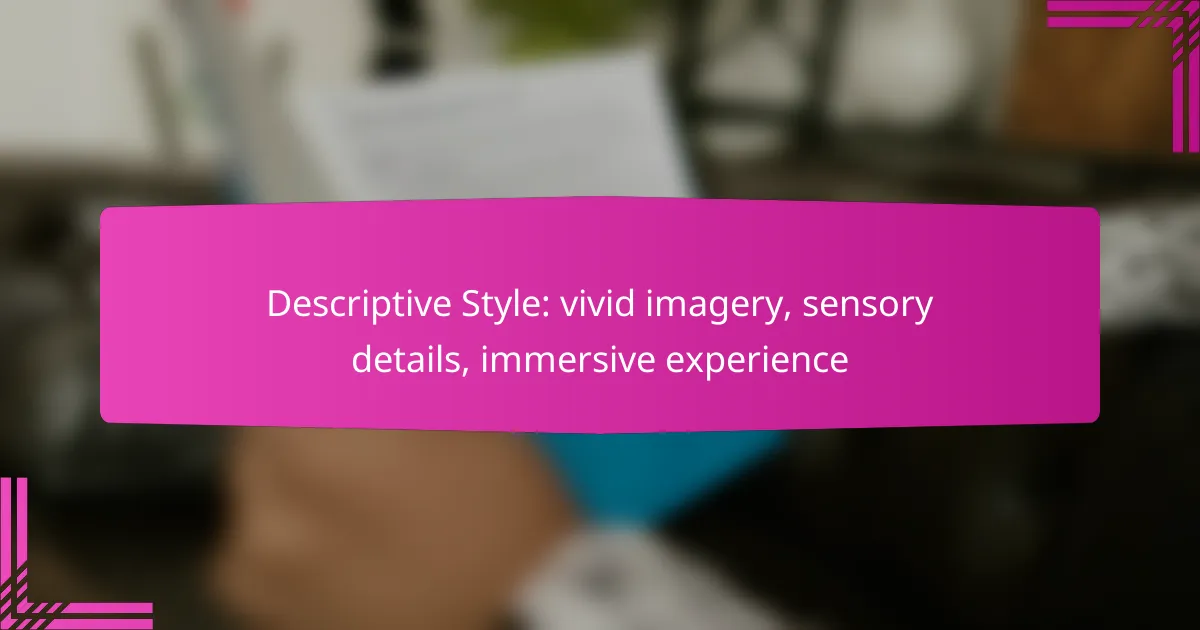Expository writing is designed to inform and explain a topic clearly and concisely, prioritizing factual information over personal opinion. This style emphasizes clarity, logical organization, and an objective tone, ensuring that the audience can easily understand the presented information. By focusing on structured content and supporting details, expository writing effectively educates readers on various subjects.

How to write expository content effectively?
Writing expository content effectively involves presenting clear, factual information in a structured manner. Focus on clarity, logical flow, and supporting details to ensure your message is easily understood by your audience.
Clear thesis statements
A clear thesis statement is essential for guiding your writing. It should succinctly express the main idea or argument of your content, allowing readers to grasp the purpose right away.
When crafting your thesis, aim for a single sentence that encapsulates your topic and perspective. This will serve as a roadmap for your readers, helping them follow your reasoning throughout the piece.
Logical structure
Organizing your content logically enhances comprehension. A typical structure includes an introduction, body paragraphs, and a conclusion, each serving a distinct purpose.
Within the body, use headings and subheadings to break down complex information into manageable sections. This approach not only aids readability but also helps readers locate specific information quickly.
Use of examples
Incorporating examples is crucial for illustrating your points effectively. Real-world scenarios or case studies can clarify abstract concepts and make your content relatable.
When selecting examples, ensure they are relevant and varied. Aim for a mix of quantitative data and qualitative anecdotes to appeal to different types of learners.
Engaging language
Using engaging language keeps readers interested and encourages them to continue reading. Avoid jargon and overly complex sentences; instead, opt for clear and concise wording.
Consider your audience when choosing your tone. A conversational style may work well for general readers, while a more formal approach might be necessary for academic or professional contexts.
Visual aids
Visual aids such as charts, graphs, and images can significantly enhance understanding. They provide a visual representation of data, making complex information more accessible.
When using visuals, ensure they are relevant and well-integrated into your text. Label them clearly and refer to them in your writing to reinforce your points and guide readers through your content.

What are the key elements of expository style?
Expository style is characterized by clarity and straightforwardness, focusing on delivering information without personal bias. The key elements include an objective tone, fact-based information, and a defined audience, all of which work together to inform and educate effectively.
Objective tone
An objective tone is essential in expository writing, as it maintains neutrality and avoids emotional language. This tone helps to present information in a way that is credible and trustworthy, allowing readers to form their own opinions based on facts rather than the writer’s feelings.
To achieve an objective tone, use third-person language and avoid subjective phrases. For example, instead of saying “I believe this method is the best,” state “This method has been shown to be effective in various studies.” This shift enhances the reliability of the content.
Fact-based information
Fact-based information is a cornerstone of expository style, ensuring that the content is grounded in verifiable data. This includes statistics, examples, and references to credible sources, which help to substantiate claims and provide readers with a solid foundation of knowledge.
When presenting facts, it’s crucial to cite sources accurately and avoid cherry-picking data. For instance, if discussing economic trends, provide a range of figures from reputable reports rather than a single statistic, which may misrepresent the situation.
Defined audience
Understanding the defined audience is vital for effective expository writing, as it shapes the content’s tone, complexity, and focus. Knowing who the readers are allows the writer to tailor the information to meet their needs and expectations, whether they are students, professionals, or the general public.
To engage your audience, consider their background knowledge and interests. For example, when writing for a technical audience, you can use industry jargon and advanced concepts, while a general audience may require simpler explanations and definitions of key terms.

How does expository writing differ from other styles?
Expository writing is primarily focused on informing or explaining a topic clearly and concisely, unlike other styles that may aim to entertain or persuade. This style emphasizes factual information, structured organization, and clarity, making it distinct from narrative and persuasive writing.
Comparison with narrative style
Narrative writing tells a story, often featuring characters, a plot, and emotional engagement. In contrast, expository writing avoids storytelling elements and focuses on delivering information without personal bias or emotional appeal. For example, a narrative might describe a personal experience, while expository writing would present facts about a historical event.
When writing narratively, the author often uses descriptive language and figurative speech to evoke feelings. Expository writing, however, relies on straightforward language and logical structure to convey information, making it more suitable for academic or instructional purposes.
Comparison with persuasive style
Persuasive writing aims to convince the reader of a particular viewpoint or action, using arguments and emotional appeals. Expository writing, on the other hand, does not seek to persuade but rather to inform, presenting facts and explanations without bias. For instance, a persuasive piece might argue for a policy change, while expository writing would outline the policy’s features and implications.
In persuasive writing, authors often employ rhetorical devices and emotional language to sway the audience. Expository writing maintains neutrality and clarity, focusing on presenting balanced information. This makes expository writing essential in educational contexts where objective understanding is crucial.

What are common mistakes in expository writing?
Common mistakes in expository writing include a lack of clarity, overly complex language, and insufficient evidence. These errors can hinder the reader’s understanding and weaken the overall effectiveness of the writing.
Lack of clarity
A lack of clarity in expository writing can confuse readers and obscure the main message. Writers should aim for straightforward language and clear organization to ensure that ideas are easily understood.
To improve clarity, use simple sentence structures and avoid jargon unless it is necessary and well-defined. Always consider the audience’s background knowledge when presenting information.
Overly complex language
Using overly complex language can alienate readers and detract from the message. Expository writing should prioritize accessibility, using familiar terms and straightforward phrasing.
Writers should strive for brevity and simplicity. For instance, instead of saying “utilize,” simply use “use.” This approach helps maintain reader engagement and comprehension.
Insufficient evidence
Insufficient evidence weakens the credibility of expository writing. Claims should be supported by relevant data, examples, or citations to enhance the argument’s validity.
When presenting information, include statistics, expert opinions, or case studies to substantiate claims. This not only bolsters the argument but also builds trust with the audience.

What tools can enhance expository writing?
Several tools can significantly improve expository writing by ensuring clarity, coherence, and engagement. Utilizing these resources can help writers refine their grammar, enhance readability, and incorporate visual elements effectively.
Grammarly for grammar checks
Grammarly is a widely used tool that helps writers identify and correct grammatical errors, punctuation mistakes, and style inconsistencies. It provides real-time feedback and suggestions, making it easier to produce polished content.
When using Grammarly, pay attention to its tone and style suggestions, which can help tailor your writing to your intended audience. However, be cautious not to rely solely on automated suggestions; always apply your judgment to maintain your unique voice.
Hemingway Editor for readability
The Hemingway Editor is designed to improve the readability of your writing by highlighting complex sentences, passive voice, and adverbs. It assigns a readability score, helping you gauge how accessible your text is to different audiences.
To use Hemingway effectively, aim for a grade level of 8 or lower for general audiences. Simplifying your sentences and using active voice can enhance clarity and engagement, making your expository writing more effective.
Canva for visual content
Canva is a graphic design tool that allows writers to create visually appealing content to complement their text. Incorporating images, infographics, and charts can enhance understanding and retention of information in expository writing.
When using Canva, consider the overall design and layout to ensure that visuals align with your written content. Use high-quality images and maintain a consistent color scheme to create a professional appearance that supports your message.

What are the benefits of expository writing in affiliate marketing?
Expository writing in affiliate marketing provides clear, informative content that helps potential customers understand products and services. This type of writing enhances user engagement and can lead to higher conversion rates by delivering valuable insights and straightforward explanations.
Builds trust with readers
Expository writing builds trust with readers by providing factual, unbiased information about products and services. When consumers feel informed, they are more likely to trust the recommendations made by affiliate marketers.
To establish credibility, focus on delivering accurate details, using reliable sources, and avoiding overly promotional language. For instance, instead of simply stating that a product is the best, explain its features, benefits, and potential drawbacks based on user reviews and expert opinions.
Additionally, incorporating data and statistics can further enhance trust. For example, citing that a product has a satisfaction rate of over 80% based on customer surveys can reassure readers of its quality. Always ensure that the information is relevant and up-to-date to maintain reader confidence.



